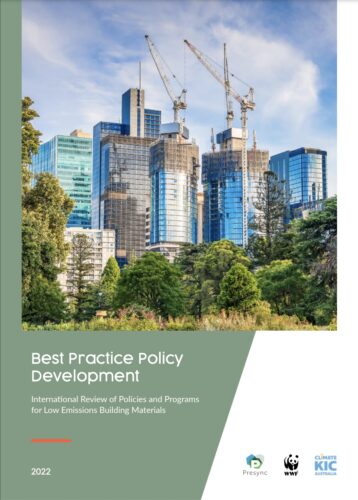Government policy to cut embodied carbon emissions is a relatively new field. This research has investigated the policy landscape, both internationally and here in Australia, to identify what has been implemented to date. It is clear that policy has a key role to play, as does strong acton by industry, if we are to reach an emissions trajectory consistent with the Paris Agreement.
The significance of embodied carbon as a proportion of our carbon budget will continue to grow as the transition of the electricity sector continues to build momentum. Operational emission reductions have over a decade’s head start, but there is opportunity to now implement informed policies with the support of industry and the benefit of international examples. The construction sector ecosystem is complex. So too are the industrial processes that produce big-ticket construction materials like cement, steel and aluminium. Appreciating this complexity is central to good policy development. It shows that system-wide change is needed to reach net-zero embodied carbon. Fortunately, many participants in the construction and material supply industries are already cutting emissions to align with a net-zero future. Working with progressive industry members to co-develop government policy will contribute to meeting the required pace of change and help de-risk policy development.
The range of policies & programs identified can be grouped into the following 5 categories:
- Policy levers to drive the market;
- Role of industry and the market;
- Rating schemes for building performance;
- Procurement – Government as an enabler for change;
- Data, tools and skills needed to get to net-zero.
The report recognises government as both a driver and enabler of change. Government can drive change through procurement policies that reward and require embodied carbon reductions through low emission construction materials and practices. Furthermore, government can enable change by supporting the development of required tools (such as taxonomy laws, inventories and calculators, and an independent carbon database), supporting skills development (for professions, trade, and researchers), and supporting the development of circular economy structures.
Research on the project was conducted by Presync, Climate-KIC Australia, and WWF-Australia. The work is funded by the Federal Government via the Department of Industry, Science, Energy and Resources and its Major Projects Implementation Team (MPIT) interjurisdictional program. Lead Authors are Hudson Worsley, Monica Richter, and Alex Nassar. You can view the entire report below.
This article originally appeared on the MECLA website.
For more information about MECLA and too access more MECLA resources, visit the MECLA website.




